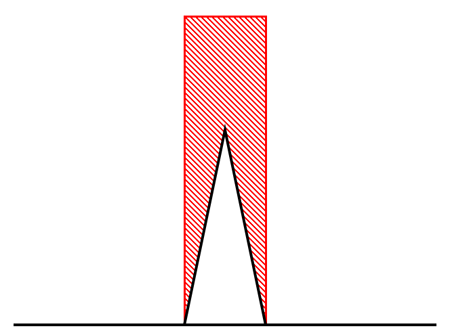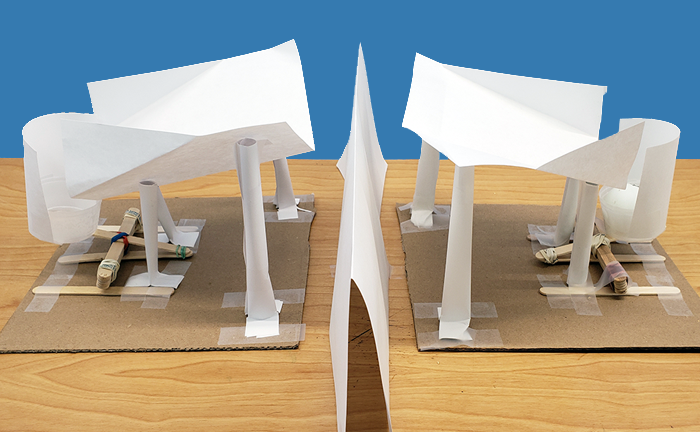Abstract
Can you build a volleyball machine? It will need one part to launch a ping pong ball over a net and another to return the ball. How many back-and-forth volleys can you get before the ball touches the ground? Looking for inspiration? You can see how other students have tackled this and other annual Science Buddies Engineering Challenges.
Teachers, lesson plan versions of this challenge are available.
Summary
This engineering challenge is based on an internal competition designed by employees at Fluor Corporation.
Objective
Use craft supplies to build a machine that can launch and return a ping pong ball back and forth over a net.
Introduction
Have you ever played volleyball, a game where you try to hit a ball back and forth over a net without letting it touch the ground? Can you imagine building a machine—actually, two machines, one on each side of the net—to do that instead? That is what you will do in this engineering design project, but you will not use a full-size volleyball. Instead, you will try to launch a ping pong ball back and forth over a much smaller "net" (a folded piece of paper). Watch this video for an introduction to the challenge:
This project allows you to explore some interesting topics in physics and engineering. Rather than explain these topics in detail, this background section will give you a brief overview, and then you can do more research on them using the links in the bibliography. If you are doing this engineering project for a science fair, do not worry about learning about every topic; instead, choose one to study in more detail.
First, this is a great opportunity to learn about simple machines, like the lever or the inclined plane. You can also investigate more complex machines like catapults, trebuchets, or slingshots, that are used to launch projectiles. Think about how you could incorporate different aspects of these machines into your design.
Speaking of projectiles, you can use this project to learn about projectile motion. How do the initial velocity and launch angle of a projectile affect its range (distance it travels)? What trajectory (path the ball takes through the air) will make it easier to catch the ball or get over the net: a high, steep trajectory or a low, shallow trajectory?
You can also use this project to learn about energy. The ball needs kinetic energy, the energy of motion, in order to fly through the air. Where will that energy come from? It could come from elastic potential energy, the energy stored in a stretched material, like a rubber band. It could come from gravitational potential energy, the energy stored in an object that is raised up off the ground. Or, the energy could come from work that you do with your hand by exerting a force. How could your machine convert one form of energy to another?
Finally, you can use this project to demonstrate the engineering design process. It is unlikely that you will think of an idea for a machine, sit down and build it, and have it work perfectly on the first try. You might need to come up with multiple designs, test more than one of them, and modify the designs to improve them. This is OK—real engineers rarely get things right on the first try!
Terms and Concepts
- Simple machine
- Lever
- Inclined plane
- Catapult
- Trebuchet
- Slingshot
- Projectile motion
- Initial velocity
- Launch angle
- Range
- Trajectory
- Kinetic energy
- Elastic potential energy
- Gravitational potential energy
- Work
- Force
Questions
- Look at the list of items in the Materials section. How could you build a machine to launch a ball using these materials?
- What will provide the energy to launch the ball?
- How could you build something to catch the ball without dropping it?
- How can you get the ball back over the net?
Bibliography
- Science Trek (n.d.). Simple Machines: Facts. Idaho Public Television. Retrieved October 30, 2017.
- Finio, B. (2017, October 16). Launch Time: The Physics of Catapult Projectile Motion. Retrieved October 30, 2017.
- Henderson, T. (n.d.). What is a projectile? The Physics Classroom. Retrieved October 30, 2017.
- Henderson, T. (n.d.). Work, Energy, and Power. The Physics Classroom. Retrieved October 30, 2017.
- Science Buddies Staff (n.d.). The Engineering Design Process. Science Buddies. Retrieved October 30, 2017.
Materials and Equipment
If you want to compare your results to those of other students who did the 2019 Engineering Challenge, you can only use the materials listed below. Each item has a maximum allowable quantity and a point cost (each) that will be deducted from your score, as described in the Procedure. Note that you can cut the materials, but costs are not prorated; e.g. if you cut a piece of paper in half and only use half of it, it still costs the full 1 point.
| Construction Materials | ||
|---|---|---|
| Item | Maximum Quantity | Point cost (each) |
| Corrugated cardboard (max size 12"x12" or 30x30 cm) | 2 | 10 |
| Large paper or plastic cups (16–18 oz, or about 450–500 mL) | 10 | 5 |
| Wooden craft sticks (4 ½" or 11.5 cm) | 20 | 1 |
| Paper (printer/copier paper, not construction paper or cardstock; letter or A4 size) | 20 | 1 |
| Wooden pencils (circular or hexagonal cross-section, approx. 7–8" or 18–20 cm length) | 20 | 1 |
| Rubber bands (size 32, 3" long unstretched and 1/8" wide) | 10 | 2 |
| Roll of clear adhesive tape (Scotch® tape or equivalent, 1/2" or 3/4" width, max length 500") | 1 | 10 |
| Tools and Testing Materials (no point cost) | |
| Item | Notes |
| Paper and pencil | For sketching design ideas |
| Scissors | For cutting construction materials |
| Sheets of paper (2) | For making net |
| Tape | For holding net to floor/table |
| Ruler | For checking net dimensions |
| Ping pong ball | |
Experimental Procedure
The objective of the 2019 Engineering Challenge was to build two devices that could launch a ping pong ball back and forth over a net without letting the ball touch the ground. While the contest is now over, you can still do this project and follow the same rules, then compare your score to high scores from teams around the world.
The more times your ball goes over the net, the higher your score will be. The "net" will be made from two pieces of 8.5"x11" paper, taped together side-to-side (along the 11" edge), and folded in half to form an upside-down "V" shape, as shown in Figure 1. If you have not already done so, watch this video for an overview of the challenge before you proceed.
 Image Credit: Ben Finio, Science Buddies / Science Buddies
Image Credit: Ben Finio, Science Buddies / Science Buddies
Figure 1. Net dimensions. Tape two 8.5x11" pieces of paper together along the 11" edge, with 1/2" of overlap, then fold in half.
Building
- Only use items listed in the Materials section.
- Build two machines (one for each side of the net). The machines can be different from each other.
- Either machine can be "active" (meaning it launches the ball) or "passive" (meaning it lets the ball roll back over the net, powered by gravity).
- Both machines must be freestanding. They cannot be taped to the ground or supported by a person.
- Your machines cannot touch each other or the net. The two machines have to be separated by the width of the net.
Testing
- One person at a time can use both hands to operate a machine to launch the ball (two people total, one for each machine).
- After the ball is launched, nobody can touch either machine until the ball has stopped moving completely.
- The ball is allowed to touch the net.
- After the ball has come to a complete stop, you cannot touch or move the ball, even if you do not touch it directly. You can use both hands to operate the machine to launch the ball back across the net.
- The ball cannot touch the ground. It is allowed to touch another material (like a piece of paper or cardboard) that is sitting on the ground.
- You continue launching the ball back and forth over the net until one of three things happens:
- The ball touches the ground.
- The ball gets "stuck" and you cannot relaunch it without touching or moving it first.
- Five minutes pass.
- If you need to make repairs, you must start over counting the number of launches at zero.
- You can do as many tests as you want to try and get a higher score, but you can only submit one high score per team.
 Image Credit: Ben Finio, Science Buddies / Science Buddies
Image Credit: Ben Finio, Science Buddies / Science Buddies
Figure 2. Side view of the net. No part of your devices can ever enter the red area above the net.
Design
Before you start building anything, it is a good idea to brainstorm some different designs. Try sketching your designs out on paper. Which designs will work best given the rules and materials you are allowed to use? Which design do you think will be the most reliable? Think about these questions and select two designs to move forward with (remember that you need two devices—one for each side of the net—and they do not need to be identical).
Build
Once you have decided on designs, it is time to start building them. You might find out that your designs "on paper" do not work as planned when you try to build them in the real world. That is OK! You do not have to stick to your original plan. You can make modifications to your design, or even start over with something completely new.
Test
Once you have built two devices, put one on each side of the net and try them out. This is your opportunity to identify weak spots in your designs and things that can be improved. Try launching the ball back and forth, and make sure you follow the rules about operating the devices and touching the ball. Here are some things to consider:
- How reliably can you launch the ball over the net? Does your device have trouble launching the ball far enough to go over the net? Do you ever launch the ball too far?
- How accurately can you launch the ball? Does the ball ever go off to the side or miss the catching device? If so, you could make your catching device bigger so it is easier to catch the ball—but that means you will need to use more materials.
- How easily does your device catch the ball? Even if the ball lands in your device initially, does it bounce or roll out? How could you stop that from happening?
- How sturdy is your device? Does it stand up to repeated use without breaking? Remember that if you need to stop for repairs, you have to start over again counting at zero!
Official Test
When you are ready to do an "official" test and calculate your score, follow these steps:
- Place your devices on either side of the net. Make sure they are not touching the net or above the net, as described by rule 5.
- Place the ping pong ball in one of your devices. From now on, you are not allowed to touch the ball directly.
- Start your stopwatch.
- Launch the ball over the net. If the ball does not make it over the net, try again. Start counting how many times the ball goes over the net until it touches the ground. The first time the ball goes over the net counts as one, even if the ball hits the ground right away. If one of your devices is "passive" (lets the ball roll back over the net), then launching the ball over and letting it roll back counts as two times.
- Wait for the ball to come to a complete stop. Do not touch or move the ball.
- Keep repeating steps 3–4 until the ball touches the ground, or until the stopwatch reaches 5 minutes, then stop counting (if the ball is in the air at exactly 5 minutes, you can wait for the ball to land, and count that towards your total). If the ball does not make it over the net, but does not touch the ground, you are allowed to try again and keep counting, as long as you do not touch the ball, and the five minute time limit has not been reached.
- Calculate your score.
Scoring
Calculate your total score using this equation:- You count the number of times the ball went over the net before touching the ground. For example, if you only launched the ball over the net once but never "caught" it (it immediately hit the ground), that still counts as "1." If you caught the ball, launched it back over the net, and then it hit the ground, that counts as "2," etc.
- The materials cost is the sum of the point costs for all the materials used in your final design, as defined in Table 1.
Troubleshooting
For troubleshooting tips, please read our FAQ: Volleyball Machine Challenge.
Ask an Expert
Global Connections
The United Nations Sustainable Development Goals (UNSDGs) are a blueprint to achieve a better and more sustainable future for all.
Variations
Frequently Asked Questions (FAQ)
Careers
If you like this project, you might enjoy exploring these related careers:
Related Links
- Science Fair Project Guide
- Other Ideas Like This
- Mechanical Engineering Project Ideas
- Physics Project Ideas
- Engineering Challenge Project Ideas
- My Favorites














